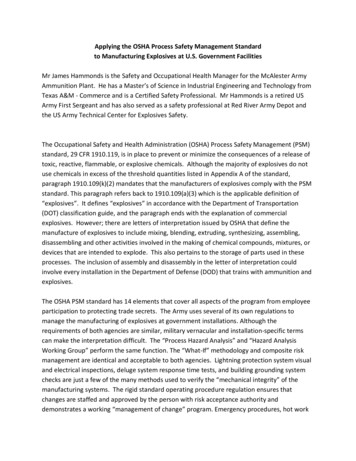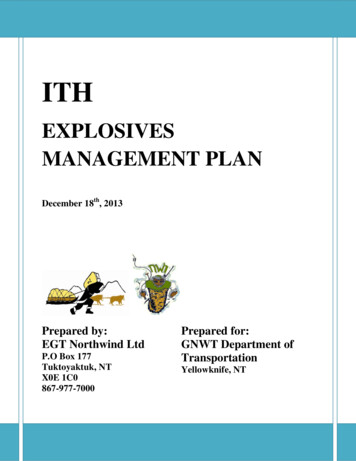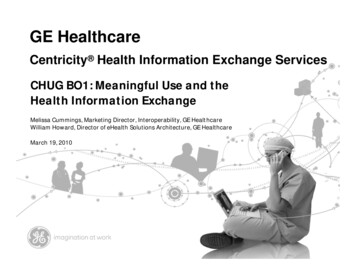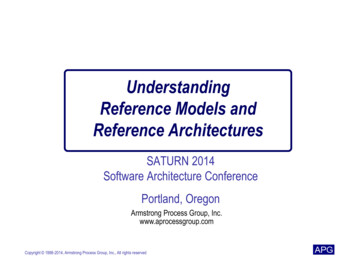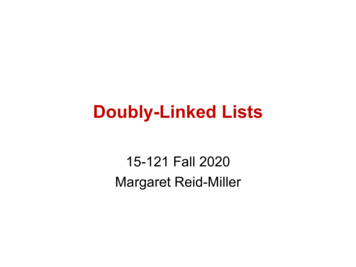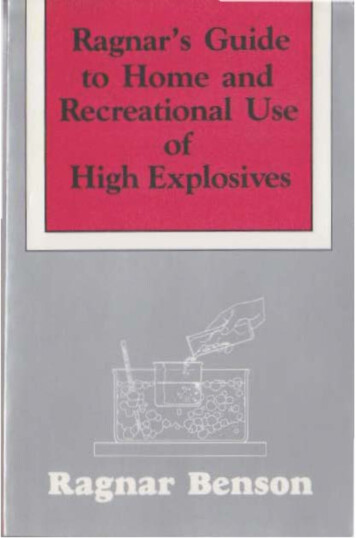
Transcription
Analysis of ExplosivesReference ListFire Debris and Explosives Subcommittee
Table of Contents1 – Books . 12- Reviews/Guides/Studies/On-line Resources . 93 - Devices . 164 - Health & Safety . 185 - Low Explosives . 186 - Canine Detection . 247 – Laboratory Sampling and Sample Prep . 258 – Intact Explosives Analysis . 299 – Homemade/Improvised Explosives/Peroxides . 5510 –Trace and Post Blast Residues Analysis . 6711 – Markers and Taggants . 8612 – Smokeless Powder . 8813 - Data Handling and Interpretation . 9514 - Quality Control . 9715 – DNA and Fingerprints. 9816 – Packaging for Submission. 10217 – Scene Response, Investigation and Sampling . 10218 – Explosives Detection . 111To navigate to a particular section directly from the table of contents:Ctrl Click the name of the section of interest; it may be necessary to then move the cursor toanother part of the page.Note: This is a comprehensive list of text books and papers related to the forensic analysis ofexplosives. It is provided primarily as an aid for forensic science practitioners and is not allencompassing.The latest update of the list is shown in the document footer.The citation format is that used by ASTM International (American Society for Testing andMaterials).
1 – Books19281. Nitroglycerine and Nitroglycerine Explosives. Naouum, P. P., and Montgomery, E. 1928.Baltimore Williams and Wilkins Co.19321. Explosives Volumes I-III 2nd Edition, Marshall, A., Gordon Press Reprint 198119431. Chemistry of Powder and Explosives, Volumes I and II, Davis, T. L., John Wiley andSons Inc., New York.19471. Pyrotechnics. 2nd Edition, Weingart, G. W., Chemical Publishing Company Inc., NewYork.19601. Encyclopedia of Explosives and Related Items, Vol. 1. Fedoroff, B. T., Aaronson, H.A.,Reese, E.F., Sheffield, O.E., Clift, G.D., 1960. PATR 2700. Picatinny Arsenal,Dover, NJ (vols. 2–10, different authors and years of publication).19611. Modern Pyrotechnics – Fundamentals of Applied Physical Pyrochemistry, First Edition1961. Ellern, E., Chemical Publishing Company.19621. The B.D.H Spot-Test Outfit Handbook 1962. British Drug Houses Limited, 2nd Edition.19631. DuPont Blaster’s Handbook. 14th Edition. Wilmington, DE: E. I. Du Pont de Nemours& Company (Inc.), Prepared by the Technical Service Section of the ExplosivesDepartment, 1963.19641. Chemistry and Technology of Explosives. Urbanski, T., 1964, Pergamon Press.1967Last updated onFebruary 19,2020Page 1
1. Army Field Manual FM 5-25, Explosives and Demolitions. Department of the UnitedStates of America War Office, May 1967.2. Chemistry and Technology of Explosives: Vol III, Urbanski, T., Pergamon Press, Oxford,England, 1967.19681. Military and Civilian Pyrotechnics. 1968 Ellern, H., Chemical Publishing Company Inc.,New York.19711. Spot Tests for Explosives and Explosive Residues. Lange, N. A. Handbook of Chemistry.10th edition 1971. McGraw Hill.2. The Anarchist Cookbook. Powell, W. Lyle Stuart, 1971.19721. Spot Tests in Inorganic Analysis. 6th Edition, Feigl, F., and Anger, V., 1972, ElsevierScience.19741. Handbook of Pyrotechnics, Brauer, K. O., 1974. Chemical Pub Co; Reprint edition Dec 11995.19761. The Analysis of Rocket Propellants, Malone, H. E., (Analysis of Organic Materials; no.12) 1976. Academic Press.2. The Particle Atlas, Vol 1, McCrone, W.C, Ann Arbor Science, Ann Arbor, MI, 1976.19771. Encyclopedia of Explosives and Related Items. Picatinny Arsenal, Dover.2. Explosives and Homemade Bombs Second Edition. Charles C. Thomas Publisher, 1977.19781. Improvised Munitions Black Book. Frankford Arsenal Philadelphia. Desert Publications.1979Last updated onFebruary 19,2020Page 2
1. The Alchemist’s Cookbook: 80 Demonstrations, 3rd Edition. Humphrey, D. A., 1979.19801. Dupont. Blaster’s Handbook. 175th Anniversary Edition.2. Explosion Investigation, First Edition 1980. Yallop, H. J., Harrogate, UK: ForensicScience Society and Edinburgh UK: Scottish Academic Press.3. High Explosives and Propellants. Fordham, S., Pergamon Press, UK, 1980.19811. The Analysis of Explosives. Yinon, J., and Zitron, S., 1st ed. Pergamon Press, Oxford.2. Fireworks: The Art, Science and Technique. Shimizu, T. Pyrotechnica Publications,1981.19821. Encyclopaedia of Explosives and Related Items, Volumes 1–10. Picatinny Arsenal,1960–1982. Picatinny Arsenal (US AARADCOM), Dover, NJ.19831. Encyclopedia of Explosives and Related Items, Kaye, S. M., Picatinny Arsenal, Vol 10,Dover 1983.19851. LLNL Explosives Handbook. Dobratz, B.M., Crawford, P.C., 1985. Lawrence LivermoreNational Laboratory, CA.19891. Explosives, Propellants and Pyrotechnics. Bailey, A., Murray, S. G., Brassey’s, UK.19911. Applied Explosives Technology for Construction and Mining. Olofsson, S.O., 1991.Applex, Arla, Sweden.2. The Poor Man’s James Bond. Vol 1. Saxon, K., Desert Publications, 1991.1992Last updated onFebruary 19,2020Page 3
1. Advances in Analysis and Detection of Explosives, Yinon, J. Kluwer AcademicPublishers, Norwell MA, 1992.2. Fireworks Principles and Practice. 2nd Edition 1992. Lancaster, R., Chemical PublishingCompany Inc., New York.3. The Do-It-Yourself Gunpowder Cookbook, 1992. McLean, D., Paladin Press.19934. Explosives for Engineers: Fourth Edition. Gregory, C.E., 1993. Clausthal - Zellerfeld,Zurich.5. Modern Methods and Applications in Analysis of Explosives. Yinon, J., Zitrin, S., 1993.John Wiley & Sons Ltd, West Sussex, England.19941. Emulsion Explosives. Wang, X., 1994. Metallurgical Industry Press, Cleveland, OH.2. Rock Blasting and Explosives Engineering. Persson, P. A., Holmberg, R., Lee, J., 1994.CRC Press, Boca Raton.19951. The Illustrated Dictionary of Pyrotechnics, 1995. Kosanke, K. L. Journal of PyrotechnicsInc.19961. Explosives Engineering. Cooper, P.W., 1996. Wiley-VCH, New York.2. Introduction to the Technology of Explosives. Cooper, P. W., Kurowski, S. R., WileyVCH 1996.3. Spot Test Analysis: Clinical, Environmental, Forensic and Geochemical Applications,Second Edition 1996. Jungreis, E. John Wiley and Sons, Inc.19971. Explosives in the Service of Man: the Nobel Heritage. Dolan, J. E., and Langer, S. S.,1997. The Royal Society of Chemistry.2. A Professionals Guide to Pyrotechnics. Donner, J., Paladin Press, 1997.Last updated onFebruary 19,2020Page 4
3. Spot Test Analysis - Clinical, Environmental, Forensic and Geochemical Applications.2nd Edition, 1997, Jungreis, E., Ed. J.D. Winefordner, New York: John Wiley and Sons,Inc. Chapter 4.3.19981. Black and smokeless powders: technologies for finding bombs and the bomb makers.National Research Council, National Academies Press, 1998.2. Blasters Handbook, Seventeenth Edition. Hopler, R.B., 1998. International Society ofExplosives Engineers, Cleveland.3. Criminalistics: An Introduction to Forensic Science, sixth ed. Saferstein, R., 1998.Prentice-Hall, Englewood Cliffs, NJ.4. Forensic Investigation of Explosions, Beveridge A. (Ed). 1998. Taylor and Francis,London.5. Nitroglycerine and Nitroglycerine Explosives, 5th Edition. Naoum, P., Angriff Press.19991. A History of Greek Fire and Gunpowder. Partington, J. R., Baltimore, MD, JohnsHopkins University Press, 1999.2. Forensic and Environmental Detection of Explosives, Yinon, J., John Wiley & Sons, Ltd,New York, NY, 1999.20001. Encyclopedia of Forensic Sciences, 2000. Siegel, J., Knupfer, G., and Saukko, P., (Eds).Academic Press London, England.20021. Handbook of Vibrational Spectroscopy, 2002. Bartick, E. G., Wiley Hoboken, NJ.2. Encyclopedia of Terrorism, 2002. Kushner, H. W., SAGE Publications Inc.3. Explosives 5th Edition. Meyer, R., Kohler, J., and Homburg, A., 2002. John Wiley-VCH,Weinheim.4. Forensic Science Handbook. Volume 1. 2nd edition 2002. Saferstein, R. Upper SaddleRiver, NJ: Prentice Hall.5. The Firecracker Cookbook. Lough, E., 2002. Delta Group Press.Last updated onFebruary 19,2020Page 5
20031. Advances in Forensic Applications of Mass Spectroscopy, 2003. Yinon, J. CRC Press,Boca Raton, FL.2. Handbook of Thermal Analysis and Calorimetry: Applications to Inorganic andMiscellaneous Materials. P. K., Gallagher and M. E., Brown, Eds, Elsevier, Amsterdam,2003.3. Understanding Explosions. Crowl, D.A., 2003. Wiley, Hoboken, NJ.20041. Encyclopedia of Chemical Technology 5th Edition, Kirk-Othmer 2004. John Wiley &Sons, Hoboken, NJ.2. Explosives Identification Guide, Second Edition. Pickett, M., 2004. Delmar CengageLearning.3. Gunpowder – Alchemy, Bombards, & Pyrotechnics: The History of the Explosive thatChanged the World. Kelly, J., New York, NY: Basic Books, 2004.4. Pyrotechnic Chemistry, Kosanke, B. J., Sturman, B., Shimizu, T., Wilson, M. A., et al.Journal of Pyrotechnics Inc. 2004,5. The Preparatory Manual of Explosives. 2nd Edition. Ledgard, J. B. The ParanoidPublications Group, 2004.20051. Energetic Materials: Particle Processing and Characterization. Teipel, U., 2005. WileyVCH.2. Fireworks Principles and Practice, 4th Edition, Lancaster, R., Chemical PublishingCompany Inc., New York.20061. Explosives and Chemical Weapons Identification. Crippin, J. B., CRC Press Taylor &Francis.2. Trace Chemical Sensing of Explosives. Woodfin, R. L., Editor. John Wiley & Sons Inc.New Jersey 2006.2007Last updated onFebruary 19,2020Page 6
1. Counter Terrorism for Emergency Responders, Second Edition 2007. Taylor & Francis,Boca Raton.2. Counterterrorist Detection Techniques of Explosives. First Edition 2007. Yinon, J. (Ed),Elsevier, Amsterdam.3. Explosives. Sixth Edition. Meyer, R., Köhler, J., Homburg, A., 2007. Wiley-VCH.4. Propellants and Explosives: Thermochemical Aspects of Combustion, Second Edition.Kubota, N., 2007. Wiley-VCH.5. Organic Chemistry of Explosives. Agrawal, J. P., Hodgson, R. D. 2007 J. Wiley & Sons.20081. Emergency Characterization of Unknown Materials, Houghton, L. R. 2008, CRC Press,Taylor and Francis Group.2. Explosives. 6th Edition, Meyer, R., Kohler, J., and Homburg, A., Wiley-VCH.3. The Chemistry of Fireworks. 2nd Edition 2008. Russell, M. S. RSC Publishing.20091. Aspects of Explosives Detection. Marshall, M., Oxley, J.C. (Eds.), 2009. Elsevier,Oxford.2. Field Confirmation Testing for Suspicious Substances. First Edition, 2009. Houghton, R.,CRC Press, Boca Raton.3. The Chemistry of Fireworks.” 2nd Edition, Russell, M. S., Royal Society of ChemistryPublishing.4. Wiley Encyclopedia of Forensic Science, Jamieson, A. and Moenssens, A. (Eds). Wiley,Chichester, UK 2009.20101. Chemistry of Pyrotechnics Basic Principles and Theory, Conkling, J. A., CRC Press,Taylor and Francis Group LLC.2. Forensic Science Handbook, Saferstein, R. Prentice Hall, Vol. 3, 2010.3. High Energy Materials: Propellants, Explosives and Pyrotechnics. Agrawal, J. P., 2010.Wiley-VCH.Last updated onFebruary 19,2020Page 7
20111. The Chemistry of Explosives: Edition 3. Akhavan, J., 2011. Royal Society of Chemistry.2. Practical Bomb Scene Investigation. Second Edition, Thurman, J. T., CRC Press.20121. Forensic Investigation of Explosions. Second Edition 2012. Beveridge, A. CRC Press,Boca Raton, FL.2. Infrared and Raman Spectroscopy in Forensic Science, Chalmers, J. M., Edwards, H. G.M., and Hargreaves, M. D., (Eds) Wiley, 2012.3. Principles and Issues in Forensic Analysis of Explosives. Oxley, J. C., Marshall, M., andLancaster S. L., Forensic Chemistry Handbook, 2012. Ed. L. Kobilinsky, , Wiley,Chapter 2;23-39.20131. Primary Explosives, Matyas, R., and Pachman, J., Springer, Heidelberg, 2013.20141. Criminalistics: An Introduction to Forensic Science, 11th ed., Saferstein, R., PearsonEducation.2. The Preparatory Manual of Explosives. 4th Edition. Ledgard, J.B., UVKCHEM 2014.20151. Brodie’s Bombs and Bombings - A Handbook to protection, security, detection, disposaland investigation for Industry, Police and Fire Departments. 4th Edition 2015. Smith, J.(Author), Charles C Thomas Pub Ltd.2. The Chemistry of Explosives, 3rd Edition, Akhavan, J., The Royal Society of Chemistry, UK.3. Forensic Chemistry. 1st Edition, 2015. Section 5 Explosives. Editor. Houck, M. M.Academic Press.20161. Crime Scene to Court: The Essentials of Forensic Science, Edition 4. White, P. Ed. 2016.Royal Society of Chemistry, Cambridge.2. Explosives. 7th Edition, Meyer, R. Kohler, J. and Homburg, A., Wiley-VCH.Last updated onFebruary 19,2020Page 8
3. Forensic Chemistry Fundamentals and Applications. Chapter. 5 Explosives, Goodpaster,J., Editor. Siegel, J. A. 2016. Wiley Blackwell.4. Materials Analysis in Forensic Science, First Edition 2016. Houck, M., Editor. AcademicPress.20171. NFPA 921: Guide for Fire and Explosion Investigations. National Fire ProtectionAgency, Quincy, MA.2. Practical Bomb Scene Investigation. Thurman, J. T., 2017 Third Edition, CRC Press.20181. A Life of Crime: My Career in Forensic Science. Lucas, D.M.L, Chapters 8-11. CRCPress 2018.2. Field Confirmation Testing for Suspicious Substances. Hardback 2009, Paperback FirstEdition 2018. Houghton, R., CRC Press, Taylor & Francis Group, Boca Raton.20191. Forensic Analysis of Fire Debris and Explosives. Editors, Evans-Nguyen, K., andHutches, K., Springer Nature Switzerland AG, 2019.2- Reviews/Guides/Studies/On-line Resources19671. Technical Manual. 1967 No. 9-1300-214 Technical Order No. 11A-1-34.19701. Explosives and Bomb Disposal Guide. Lenz, R.R. Charles C. Thomas, 1970.19721. Introduction to Explosives. Newhouser, C. R., Gaithersburg, MD: National Bomb DataCenter, 1972.1973Last updated onFebruary 19,2020Page 9
1. Blasting Cap Recognition and Identification Manual, Brucker, E. W., 1973, Publisher;International Assn. Chiefs of Police.19751. Friend, Robert C., “Explosives Training Manual: A Complete Illustrated Course dealing withthe Safe Handling and Effective Use of Explosives.” Wilmington, DE: ABA Publishing Co.19781. Higgs, D. G., Jones, P. N., Markham, J. A. and Newton, E., “A review of explosivessabotage and its investigation in civil aircraft,” Journal of the Forensic Science Society1978 18, 137.19871. Atlas Powder Co, 1987. “Explosives and Rock Blasting,” Field Technical Operations.Atlas Powder Co, Dallas.19891. Karpas, Z. "Forensic Science Applications of Ion Mobility Spectrometry" Forensic Sci.Rev. 1989, 1(2) 103-119 December.19901. "Industrial Explosives - A Brief History of Their Development and Use." Meyers, S., andShanley, E.S., J. Hazard. Mater. 1990, 23( ) 183-201.2. Meyers, S. and Shanley, E.S. "Industrial Explosives - A Brief History of TheirDevelopment and Use" J. Hazard. Mater. 1990, 23 183-201.19921. Feraday, A.W., "The Semtex-H Story." Adv. Anal. Detect. Explos. Proc. 4th Inter. Symp.Anal. Detect. Explos., September 7-10, 1992 Jerusalem, Israel Yinon, J. -Ed. KluwerAcademic Publishers Dordrecht, Holland 1992 pp. 67-72.2. Hubball, J. "The Use of Chromatography in Forensic Science" Adv. Chromatogr. Vol. 32Giddings, J.C.; Grushka, E. and Brown, P.R. (Editors) New York Marcel Dekker 1992,pp. 131-172.19931. Hiley, R.W., "Investigations of Thin Layer Chromatographic Techniques Used for ForensicExplosives Analysis in the Early 1970s." J. Forensic Sci. 1993, 38(4) 864-873 July.Last updated onFebruary 19,2020Page 10
2. Kolla, P. and Hohenstatt, P. "Stability of Explosives Traces on Different Supports"Forensic Sci. Int. June 1993, 60 (1, 2) 127-137.19941. McCord, B.R.; Hargadon, K.A.; Hall, K.E. and Burmeister, S.G. "Forensic Analysis ofExplosives Using Ion Chromatographic Methods" Anal. Chim. Acta 1994, 288(1-2) 43-56March 30.19951. Donaldson, T. P., "Overview of United Kingdom Research." Compendium, Inter. Explos.Symp. Fairfax, VA September 18-22, 1995 Treasury Dept., BATF April 1996 pp. 111 117.2. Foulger, B., and Hubbard, P. J., "A Review of Techniques Examined by U.K. Authorities toPrevent or Inhibit the Illegal Use of Fertiliser in Terrorist Devices." Compendium, Inter.Explos. Symp. Fairfax, VA September 18-22, 1995 Treasury Dept., BATF April 1996pp. 129-133.19961. Crowson, A., Cullum, H. E., Hiley, R. W., and Lowe, A. M., “A survey of highexplosives traces in public places” 1996. J. Forensic Sci. 41(6): 980-989.2. Fink, C. L., Micklich, B. J., Sagalovsky, L., Smith, D. L., and Yule, T. J., "ExplosivesDetection Studies Using Fast-Neutron Transmission Spectroscopy." Proc. 2nd Explos.Detect. Technol. Symp. Aviation Secur. Technol. Conf. Makky, W. -Chair November 1215, 1996 FAA Atlantic City, NJ pp. 142-147.3. Fox, F., Sisk, S., DiBartolo, R., Miller, J. F. and Gandy, J., "Immersion Studies of AircraftParts Exposed to Plastic Explosives." Proc. 2nd Explos. Detect. Technol. Symp. AviationSecur. Technol. Conf. Makky, W. -Chair November 12-15, 1996 FAA Atlantic City, NJpp. 31-37.19971. Jones, M.L. and Lee, E. "Impact Sensitivity of Nitroglycerin" J. Energ. Mat. 1997, 15193-204.19981. Black and Smokeless Powders: Technologies for Finding Bombs and the Bomb Makers.National Research Council. National Academy Press, 1998.Last updated onFebruary 19,2020Page 11
2. McCord, B.R. and Bender, E.C. "Chromatography of Explosives" in: Forensic Invest.Explos. Beveridge, A.D. - Ed. London, Taylor & Francis 1998 pp. 231-265.3. Hopler, R.B. "The History, Development and Characteristics of Explosives andPropellants." in: Forensic Invest. Explos. Beveridge, A.D. - Ed. London, Taylor &Francis 1998 pp. 1-13.4. Leach, C.; Flower, P.; Hollands, R.; Flynn, S.; Marshall, E. and Kendrick, J. "Plasticisersin Energetic Materials Formulations. A UK Overview" Int. Annu. Conf. ICT 1998 29th(Energetic Materials) 2.1-2.14.19991. McAvoy, Y. Backstrom, B.; Janhunen, K. Stewart, A. and Cole, M.D. "SupercriticalFluid Chromatography in Forensic Science: A Critical Appraisal" Forensic Sci. Int. 1999,99 (2) 107-122.2. Midkiff, C. R., “Analysis and Detection of Explosives, Published Papers, Results andPresentations: 1988-1998. August 1999. Available athttps://www.swgfex.com/publications.3. Picket, M., “Explosives Identification Guide.” Albany, NY, Delmar Publishers, 1999.20001. National Institute of Justice, “A Guide for Explosion and Bombing Scene Investigation.”2000. Available at https://www.swgfex.com/publications.2. TWGFEX/NCFS, 2000. “A Guide for Explosion and Bombing Scene Investigation.”DOJ, Washington, DC.3. A Guide for Explosion and Bombing Scene Investigation. National Institute of Justice, writtenand approved by the Technical Working Group for Bombing Scene Investigation. U.S.Department of Justice, 2000.20011. Walker, C., Cullum, H. E., Hiley, R. W., “An Environmental Survey Relating toImprovised and Emulsion Gel Explosives” J. Forensic Sci, 2001: 46(2): 254-267.20031. Oxley, J. C., “The thermal stability of explosives.” in Handbook of Thermal Analysis andCalorimetry: Applications to Inorganic and Miscellaneous Materials, P. K., Gallagherand M. E., Brown, Eds, Elsevier, Chapter 8, Amsterdam, 2003 Vol. 2, pp. 349–369.Last updated onFebruary 19,2020Page 12
2. Oxley, J. C., Smith, J. L., Resende, E., Pearce, E., and Chamberlain, T. “Trends inexplosive contamination.” Journal of Forensic Sciences 2003 48(2), 1–9.20041. Cullum, H. E., McGavigan, C., Uttley, C. Z., Stroud, M. A., and Warren, D. C., “Asecond survey of background levels of explosives and related compounds in theenvironment” 2004. J. Forensic Sci 49(4): 684-690.2. Hopen, T., J., “Dr. Walter C. McCrone’s Contribution to the Characterization andIdentification of Explosives.” J Forensic Sci. 2004 Mar; 49(2):275-6.3. Nambayah, M., and Quickenden, T., “A Quantitative Assessment of ChemicalTechniques for Detecting Traces of Explosives at Counter-Terrorist Portals.”Talanta. 2004 May 28; 63(2):461-7.4. The Technical and Scientific Working Group on Fire and Explosion Analysis(T/SWGFEX). “Recommended Guidelines for Forensic Identification of IntactExplosives.” July 2004. Available at https://www.swgfex.com/publications.20051. University of Rhode Island, “Explosives Database.”. Available athttp://expdb.chm.uri.edu/20061. Technical/Scientific Working Group for Fire and Explosions/National Center forForensic Science (T/SWGFEX/NCFS), “Smokeless Powder Database.” Available athttp://www.ilrc.ucf.edu/powders/20071. Borusiewicz, R., ‘A review of methods of preparing samples for chromotographicanalysis for the presence of organic explosive substances.’ Problems of Forensic Sciences2007 LXIX, 5-29.2. Gaurav, D., Malik, A. K., and Rai, P. K., ‘High performance liquid chromatographicmethods for the analysis of explosives.” Critical Reviews in Analytical Chemistry 200737, 227–268.3. The Technical and Scientific Working Group on Fire and Explosion Analysis(T/SWGFEX). “Recommended Guidelines for Forensic Identification of Post BlastExplosive Residues.” 2007. Available at https://www.swgfex.com/publications.4. Technical Support Working Group. “Indicators and Warnings for HomemadeExplosives.” First Edition, December 2007, For Official Use Only.Last updated onFebruary 19,2020Page 13
20081. Lahoda, K.G., Collin, O.L., Mathis, H.E., LeClair, Wise, S.H., and McCord, B. R., “Asurvey of background levels of explosives and related compounds in the environment”2008 J. Forensic Sci. 53(4): 802-806.2. Tagliaro, F., and Bortolotti, F., “Recent Advances in the Applications of CE to ForensicSciences (2005 – 2007).” Electrophoresis. 2008 Jan; 29(1):260-8.20091. Burks, R. M., and Hage, D. S., “Current trends in the detection of peroxide-basedexplosives.” Anal Bioanal Chem. 2009 Sep; 395(2):301-13. doi: 10.1007/s00216-0092968-5. Epub 2009 Jul 31.2. Gottfried, J. L., De Lucia, F. C., Munson, C. A., and Mizolek, A. W., “Laser-inducedbreakdown spectroscopy for detection of explosives residues: a review of recentadvances, challenges, and future prospects.” Anal Bioanal Chem, 2009. DOI10.1007/s00216-009-2802-0.3. Naval Explosive Ordnance Disposal Technology Division, Explosives: Military,Commercial, Homemade, and Precursors Identification Guide, Version 2.0 2009. ForOfficial Use Only.4. Oxley, J. C., Smith, J. L., Bernier, E., Moran, J. S., and Luongo, J., “Hair as forensicevidence of explosive handling.” Propellants, Explosives, Pyrotechnics 2009 34(4), 307–314.5. Wallin, S., Pettersson, A., Ostmark, H., and Hobro, A., “Laser-Based Standoff Detectionof Explosives: A Critical Review.” Anal Bioanal Chem. 2009 Sep; 395(2):259-74.20101. Nair, U. R., Asthana, S. N., Subhananda Rao, A., and Gandhe, B. R., “Advances in HighEnergy Materials.” Defence Science Journal, Vol. 60, No. 2, March 2010, pp. 137-151.20111. Fernandez de la Ossa, A., Lopez-Lopez, M., Torre, M., and Garcia-Ruiz, C., “Analyticaltechniques in the study of highly-nitrated nitrocellulose.” Trends in Analytical Chemistry,Vol 30, No. 11, 2011.2. Makinen, M., Nousiainen, M., and Sillanpaa, M., “Ion Spectrometric DetectionTechnologies for Ultra-Traces of Explosives: A Review.” Mass Spectrometry Reviews,2011, 30, 940– 973.Last updated onFebruary 19,2020Page 14
3. Sorensen, A., McGill, W. L., “What to look for in the aftermath of an explosion? Areview of blast scene damage observables.” Engineering Failure Analysis 2011;18(3):836-845.20121. Caygill, J. S., Davis, and Higson, S. P. J., “Current trends in explosive detectiontechniques.” Talanta, Volume 88, 15 January 2012, Pages 14-29.2. Ostmark, H., Wallin, A., and Ang, H., “Vapor pressure of explosives: a critical review.”Propellants Explos, Pyrotech 37 (2012) 12-13.3. Oxley, J. C., Smith, J. L., Kirschenbaum, L. J., Marimiganti, S., Efremenko, I., Zach, R.,and Zeiri, Y., “Accumulation of explosives in hair – part 3: binding site study.” Journalof Forensic Sciences 2012 57, 623–635.20131. Bureau of Alcohol, Tobacco, Firearms, and Explosives (ATF) Department of Justice“List of Explosives Materials.” Available at https://www.atf.gov/file/97716/download2. Morelato, M, Beavis, A., Kirkbride, P., and Roux, C., “Forensic applications ofdesorption electrospray ionisation mass spectrometry (DESI-MS).” Forensic ScienceInternational 2013; 226(1-3):10-21.20141. Barron, L., and Gilchrist, E., “Ion chromatography-mass spectrometry: A review ofrecent technologies and applications in forensic and environmental explosives analysis.”Analytica Chimica Acta 2014; 806:27-54.2. Fountain, A. I., Christesen, S., Moon, R., and Guicheteau, J., “Recent advances andremaining challenges for spectroscopic detection of explosives threats.” Appl. Spectrosc.OA 68 (2014) 795-811.3. Oxley, J.C., “Explosive detection: How we got here and where are we going?”International Journal of Energetic Materials and Chemical Propulsion 2014; 13(4):373381.20171. NFPA 921: “Guide for Fire and Explosion Investigations,” National Fire ProtectionAgency, Quincy, MA.20181. Smyth, A., and Sims, M.R., “Detection of fingermarks from post-blast debris: A review.”Journal of Forensic Identification 2018; 63(8):369-378.Last updated onFebruary 19,2020Page 15
20191. Gillen, G., Verkouteren, J., Najarro, M., Staymates, M., Verkouteren, M., Fletcher,R., Muramoto, S., Staymates, J., Lawrence, J., Robinson, L., and Sisco, E. “Reviewof the National Institute of Standards and Technology Research Program in TraceContraband Detection.” Homeland Security and Public Safety: Research,Applications and Standards 2019 Oct. ASTM International.https://www.astm.org/DIGITAL LIBRARY/STP/PAGES/STP161420180050.htm2. Greibl, W., “End User Commentary on Advances in the Analysis of Explosives.Emerging Technologies for the Analysis of Forensic Traces.” 2019; 978-3-030-20542-3 163. Romolo, F. S., and Palucci, A., “Advances in the Analysis of Explosives. EmergingTechnologies for the Analysis of Forensic Traces.” 1007/978-3-030-20542-3 153 – Explosive Devices19761. Crockett, T. S., and Newhouser, C. R., “Recognition of Explosive and Incendiary Devices.Part I – Hand and Rifle Grenades 03-1 and Part II – Land Mines; Artillery, Mortar, andRocket Projectiles 03-2.” The National Bomb Data Centre Research Division, InternationalAssociation of Chiefs of Police, 1976.2. McAuley, D., "Unusual Remotely Delivered Devices" Presented: Explosion InvestigationSymposium Belfast, Northern Ireland March 20-21, 1995 Abstract: Sci. Justice 1998, 38(1)49-50 January-March.3. McAuley, D. "The Development of Improvised Mortar Bombs in Northern Ireland by theProvisional IRA" Presented: Explosion Investigation Symposium Belfast, Northern IrelandMarch 20-21, 1995 Abstract: Sci. Justice 1998, 38(1) 50 January-March.19921. Prime, R. J., and McGee, E., "The Evaluation and Analysis of Plasticine or Modeling ClayAfter its Use as a Hoax Explosive Substance" Presented: 39th Annual Meeting, C.S.F.S.Halifax, Nova Scotia August 20-25, 1992 abstract: Can. Soc. Forensic Sci. J. 1992, 25(3)158 September1994Last updated onFebruary 19,2020Page 16
1. Scott, L., “Pipe and Fire Bomb Designs: A Guide for Police Bomb Technicians.” PaladinPress, 1994.19971. Missliwetz, J., Schneider, B., Oppenheim, H., and Wieser, I., "Injuries Due to Letter Bombs"J. Forensic Sci. 1997, 42(6) 981-985 November.20011. Oxley, J. C., Smith, J. L, Resende E., Rogers, E., Strobel, R. A., and Bender, E. C.,“Improvised explosive devices: pipe bombs.” 2001 Journal of Forensic Sciences 46 (3),510–534.2. Oxley, J. C., Smith, J. L., and Resende, E., “Determining Explosivity Part II: Comparisonof Small Scale Cartridge Tests to Actual Pipe Bombs.” J Forensic Sci. 2001 Sep;46(5):1070-5.20031. Walsh, G., A., Inal, O, T., and Romero, V. D., “A potential metallographic technique forthe investigation of pipe bombings.” Journal of Forensic Sciences 2003: 48(5), 484–500.20051. Chumbley, L. S., and Laabs, F. C., “Analysis of Explosive Damage in Metals UsingOrientation Imaging Microscopy.” J Forensic Sci 2005 Jan 50(1):104-111.20091. Quirk, A. T., Bellerby, J. M., Carter, J. F., Thomas, F. A., and Hill, J. C., “An initialevaluation of stable isotopic characterisation of post-blast plastic debris from improvisedexplosive devices.” Science and Justice 49 (2009) 87–93.20101. Gregory, O., Oxley, J. C., Smith, J. L., Platek, M., Ghonem, H., Bernier, E., Downey, M.,and Cumminskey, C., “Microstructural characterization of pipe bomb fragments,”Materials Characterization 2010 61(3), 347–354.2. Kuzmin, V., Mikheev, D., and Kozak, G., Detonability of Ammonium Nitrate andmixtures on its Base.’ Central European Journal of Energetic Materials, 7(4) · January2010.2011
Mar 27, 2020 · Note: This is a comprehensive list of text books and papers related to the forensic analysis of explosives. It is provided primarily as an aid for forensic science pract
